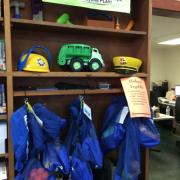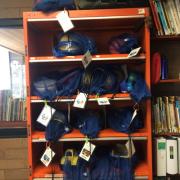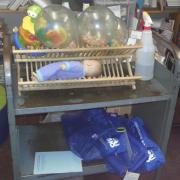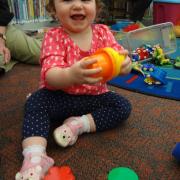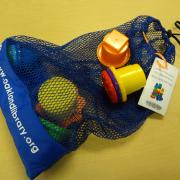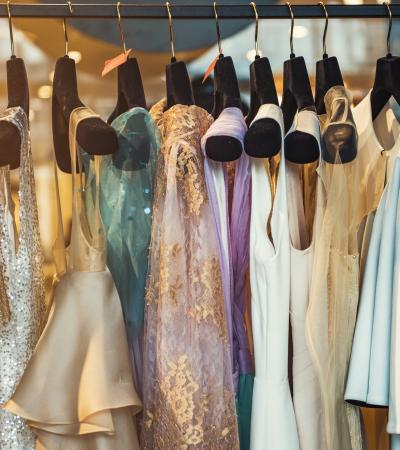The Oakland Public Library (OPL) Toy Lending Library began in 2014 as a pilot funded by a Pacific Library Partnership Innovations & Technology grant. The program involved more than 30 sets of toys at each of the four pilot locations: the main library, Elmhurst, César Chávez and West Oakland library branches. Since then, the collection has expanded to the Melrose and Rockridge branches as well, for a total of six sites.
The toys are fully cataloged and intended to circulate as seamlessly as the other juvenile items, with the same loan rules and fine structure. The toy lending collection aims to connect play with learning in deliberate ways across library services and environments.
Advanced Planning
OPL’s goals were to create a pilot toy lending library at four OPL locations, then to transition to a sustainable permanent toy collection. We determined that the toy lending library would be successful if parents who reported using it also reported that they “received more readiness information and engaged in more transition activities with their child.”
Planning began a year in advance of the collection’s launch in summer 2014. The planning team included four branch children’s librarians (each of whom wanted to house a circulating toy collection in their branches); OPL’s children’s services coordinator; and a children’s collection management library aide.
In addition to the planning team, we also had a working group comprised of the children's librarians at the four pilot sites, and myself. For selection of the toys and materials, one of the branch librarians created an initial proposed order. The working group then offered feedback before she finalized the selections.
Steps for creating the collection included:
- Working group established collection guidelines
- Selected and ordered toys and materials
- Toys were received, cataloged and processed
- Working group developed outreach materials
- The toy lending collection was launched at four sites and promoted through printed and online material
For this process, we ordered, cataloged and processed the materials from our children's services office, rather than through the library's central acquisitions/processing flow. This was mainly because it's an entirely different set of vendors, cataloging guidelines and processing materials. This required inital meetings with our cataloging department to create cataloging guidelines, subject headings and a classification system. We continued to consult with the department once the toys were circulating. Amy Martin, the children's collection development librarian in our children's services office, now fully manages this workflow.
Unexpected challenges included: children’s librarians having to catalog items; writing transparent documentation and instructions for staff; and dealing with inconsistent shelving in different locations.
Marketing
We have marketed the toy lending collection through printed posters and postcards. (See a poster under Attachments at right.) These have been displayed in branches and distributed to local child-friendly organizations. We have also promoted the toys through OPL’s Children’s Services blog, Facebook and Twitter.
Budgeting
We spent $13,000 on toys and bags; $2,000 on display furniture; $1,000 for promotional materials; and $200 for sanitizing supplies. We estimate a cost of about $8,000 in staff salary for the time spent working on the collection.
The $13,000 we spent on toys and bags bought a large collection of toys for each of four sites. (View a full list of the toys in the collection.) However, a smaller library could easily build an appealing toy collection with an initial expenditure of $500 to $1,000.
Program Execution
The toy lending library is kept behind the reference desk for people to request for check-out. This is done because of space and to avoid people opening the bags in the library. (We don't allow people to play with the toys that we lend out in the library because we have toys out on the floor already. Keeping the toys available only for check-out ensures that they stay contained and ready to go home with someone.)
A survey of toy borrowers showed that the response has been overwhelmingly positive. All respondents indicated that the toy they borrowed was easy to use and their child enjoyed it. Circulation is strong; from July 2015 to June 2016, the average OPL toy was checked out 3.89 times. By comparison, the average picture book at OPL checked out 3.09 times over the same time period. One borrower commented, “We love it! It’s great!”
To evaluate the program, we distributed a paper survey to parents checking out toys, and collected them at the reference desks of the four toy lending sites. (See the evaluation form under Attachments at right.)
Advice
Start by defining your parameters: selection criteria and collection guiding principles. (See OPL's collection guidelines under Attachments at right.) For example, we decided that toys would be geared toward children aged 0 to 5 and be limited to ones with fewer than eight pieces. Your toy lending procedures will all flow from these principles.
Test run your packaging and bar-coding. Our bags, thankfully, proved correct, but we did do a small batch first. Our tags, attached with zip ties, had to have a few iterations, and proved more labor-intensive than expected. Consider labor involved, acquisition of materials, and how the toy and packaging will handle being returned in a drop box or delivery bin.
Expect the unexpected. There will be something you did not anticipate or overlooked.

